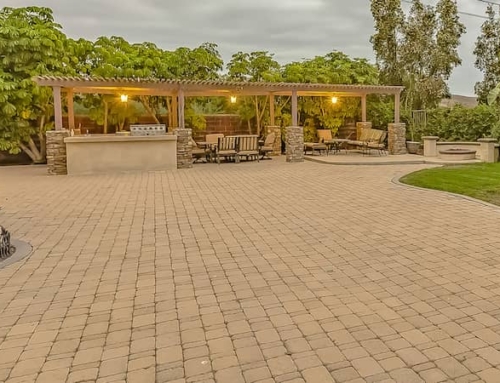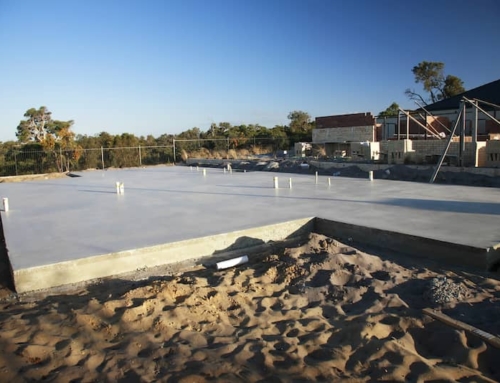Concrete resurfacing is a topic that is essential when it comes to maintaining the aesthetics and longevity of your outdoor spaces. However, even a beautiful decorative concrete resurfacing job can quickly fall victim to an insidious destroyer known as concrete spalling. Protecting your concrete, including concrete patio resurfacing, begins with understanding this issue and taking proactive steps. A primary defense against concrete spalling is waterproofing the concrete, which we’ll delve into throughout this article.
Brief Overview of Concrete Spalling
Concrete spalling, commonly called concrete flaking or chipping, is a common problem that can lead to significant structural issues over time. It occurs when water enters the concrete, expands, and contracts due to freezing and thawing cycles.
Preventing concrete spalling is crucial to maintaining your concrete structures’ integrity, aesthetics, and safety. Left unchecked. It can lead to severe damage requiring expensive repairs or replacement.
Causes of Concrete Spalling
Here are some common causes of concrete spalling:
1. Freeze-Thaw Cycles
When water infiltrates porous concrete and freezes, it expands, creating internal pressure. When this ice melts, spaces are left behind, leading to spalling.
2. De-icing Salts
De-icing salts can accelerate the freeze-thaw cycle, increasing the likelihood of spalling.
3. Corrosion of Reinforcing Steel
When the water reaches the reinforcing steel bars (rebars) in concrete, it can cause them to corrode and expand, leading to spalling.
Consequences of Concrete Spalling
1. Structural Integrity Loss
Spalling can weaken the concrete structure, leading to serious safety concerns.
2. Aesthetics and Property Value Reduction
The unsightly appearance of spalling can decrease property value and curb appeal.
3. Safety Concerns
Pieces of concrete can break off and fall, posing a risk to people and property below.
The Role of Waterproofing the Concrete in Preservation

Types of Waterproofing Solutions
When discussing waterproofing the concrete, we refer to various products and methods to prevent water from entering and damaging the concrete. The type of waterproofing solution you choose depends on several factors, including the nature and condition of the concrete structure, the surrounding environment, and the specific challenges the site presents.
1. Concrete Sealers
It is possible to use concrete sealers in both residential and commercial settings. They adhere to the surface of the concrete and work by forming a protective layer that resists water infiltration. Concrete sealers come in two primary types: penetrating sealers, which seep into the concrete and react chemically to form a waterproof barrier, and film-forming sealers, which create a protective layer on the concrete surface.
When used in concrete resurfacing, sealers provide waterproofing benefits and can enhance the look of decorative concrete by adding a sheen. They are a popular choice for concrete patio resurfacing due to their balance of aesthetic appeal and protection.
2. Waterproofing Membranes
Waterproofing membranes are a robust solution designed for applications requiring a higher degree of waterproofing. They usually consist of rubber or plastic materials installed directly onto the concrete surface.
Two major types of membranes are sheet-based membranes and liquid-applied membranes. Sheet-based membranes are rolled onto the concrete, while liquid-applied membranes are sprayed or rolled on and then dry to form a seamless, flexible barrier against water penetration. Waterproofing membranes are highly effective but require professional installation to ensure correct application.
3. Cementitious Waterproofing
A cementitious waterproofing compound is applied to concrete surfaces. It forms a rigid or semi-flexible waterproof barrier. It is easy to apply and commonly used in internal areas not subject to movement or expansion, such as basements and bathrooms. However, there may be better choices for outdoor areas with significant temperature fluctuations.
How Waterproofing the Concrete Helps Prevent Spalling

The solutions for waterproofing the concrete ensure the structural stability of concrete surfaces. They offer robust defense mechanisms against the fundamental spalling causes when correctly applied.
1. Protection Against Water Penetration
The first and most direct way that waterproofing the concrete prevents spalling is by preventing water from entering the concrete in the first place. Whether it’s a sealer, membrane, or cementitious coating, the waterproofing solution acts as a physical barrier that stops water from permeating the concrete’s surface.
2. Reducing the Impact of Freeze-Thaw Cycles
Because waterproofing stops water from entering the concrete, it reduces the impact of freeze-thaw cycles—a primary cause of spalling. Without water seeping into the concrete and freezing, the internal expansion and contraction process that leads to spalling is significantly reduced.
3. Preventing Corrosion of Reinforcing Steel
Concrete structures often contain reinforcing steel bars, known as rebars. When water permeates the concrete and reaches these bars, it can cause them to rust and corrode. This corrosion leads to expansion, which can create internal pressure that leads to spalling. By preventing water from penetrating the concrete, waterproofing also helps to protect the reinforcing steel from corrosion, thereby helping to prevent spalling.
Critical Considerations for Effective Waterproofing
A. Quality of Waterproofing Material
Ensure you use high-quality waterproofing material for adequate, long-lasting protection against spalling.
B. Correct Application Method
Each waterproofing solution requires a specific application method for optimal performance. Follow manufacturer instructions closely.
C. Proper Surface Preparation
Before applying any waterproofing solution, the concrete surface must be clean, dry, and free of any previous coatings or contaminants.
D. Ongoing Maintenance and Inspection
Regular inspection and maintenance are vital to ensuring your waterproofing remains effective.
Waterproofing the Concrete is Essential For Long Term Protection
Ensure you use high-quality waterproofing material for adequate, long-lasting protection against spalling.
Waterproofing the concrete plays a crucial role in preserving the integrity of your concrete structures. It’s the best preventive measure against concrete spalling and vital to any concrete resurfacing job.
Paying attention to spalling becomes a problem. Proactively maintaining and waterproofing your concrete surfaces is an innovative, cost-effective move.
Creative Resurfacing Solutions proudly offers innovative products that provide top-notch concrete protection. Our premier waterproofing membrane product offers superior water resistance, ensuring your decorative concrete resurfacing project or concrete floor resurfacing job stands the test of time. With this powerful waterproofing tool, you can confidently guard against concrete spalling and enjoy beautifully preserved concrete for years.






